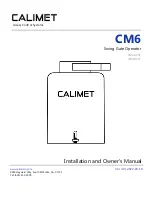
ANTES 24
ENGLISH
Guide for the installer
Page 5
Thank you for choosing our product. APRITECH is sure that it will give you
all the performances you are looking for. All our products are the result
of a long experience in the field of the automated systems, reinforced
by the fact of being part of the world leading group of this sector.
In the middle of the handbook you will find a detachable
brochure with the images for the installation.
The
ANTES 24
automated system for residential sliding gates is an
electro-mechanical operator which transmits motion to the leaf through
a pinion gear suitably coupled to a rack fitted on the gate.
The non-reversing system ensures mechanical locking when the motor
is not operating and, therefore, installing a lock is unnecessary. A handy
release facility makes it possible to move the gate in the event of a
power cut or fault.
All characteristics and behaviours indicated in this manual
refer to homogeneous installations, every component of the
automated system is produced by APRITECH.
1. DESCRIPTION AND TECHNICAL SPECIFICATIONS
With reference to Figure 1
Pos
Description
햲
Gearmotor
햳
Protective housing
햴
Control unit (if on board)
햵
Pinion
햶
Foundation plate
햷
Magnetic sensor
햸
Release device
햹
Battery Kit (Optional)
햺
Motor housing
T
ECHNICAL
SPECIFICATIONS
OF
OPERATORS
Power supply
230/115 V~ 50/60Hz
Motor Power supply
24 Vdc
Absorbed power
60 W
Pinion
Z16 M4
Max torque
13.5 Nm
Nominal torque
9 Nm
Max thrust
40 daN
Consecutive cycles
30 cycles
햲
Use frequency a 20°C
Residential use
Recommended daily cycles
80 cycles
Operating ambient temperature
-20°C +55°C
Operator weight
10.5 Kg
Protection class
IP44
Max gate weight
400 Kg
Gate speed
12 m/min
Max gate length
10 m
Dimensions
240 x 290 x 270 mm
햲
Consecutive number of cycles on gates with max. length of 5 metres.
2. ELECTRICAL SET-UP
With reference to Figure 2
Pos
Description
N°/sectn. of cables
햲
Operator
3x1.5 mm
2
햳
Photocells TX
2x0.5 mm
2
햴
Photocells RX
4x0.5 mm
2
햵
Key push-button
3 / 2x0.5 mm
2
햶
Flashing lamp
2x1.5 mm
2
햷
External antenna
Coaxial cable supplied as
standard
To lay cables, use adequate rigid and/or flexible tubes.
Always separate connection cables of low voltage acces-
sories from those operating at 230/115V~. To prevent any
interference whatever, use separate sheaths.
3. INSTALLING THE AUTOMATED SYSTEM
3.1. PRELIMINARY CHECKS
To ensure a correctly operating automated system, the structure of the
existing gate or gate to be built must satisfy the following requirements:
• The weight and dimensions of the gate must comply with the indica-
tions given in the table of the technical specifications;
• Check if an efficient earth socket is available for connecting the
operator;
• The mechanical construction elements must comply with the provi-
sions of the EN12604 and EN12605 Standards;
• Smooth leaf surface (without any projections);
• Smooth, uniform gate movement, without any friction during the
entire travel;
• No sideward leaf swings;
• Top and bottom sliding systems must be in excellent condition. It is
preferable to use a ground-level guide with rounded groove to obtain
reduced sliding friction.
• Only two sliding wheels are present
• Mechanical safety stops required to prevent the danger of gate de-
railment; these stops must be firmly secured to the ground or to the
ground-level guide at about 40 mm beyond the travel limit position.
• No mechanical closing locks.
We advise you to carry out the metalwork jobs before instal-
ling the automated system.
The condition of the structure directly influences the reliability
and safety of the automated system.
3.2. INSTALLING THE OPERATOR
1.
Assemble the foundation plate as in Fig.3.
2.
Dig a cavity for the foundation plate as shown in Fig. 4. The founda-
tion plate must be located as shown in Fig. 5 (right closing) or Fig.6
(left closing) to ensure correct meshing between rack and pinion.
3.
Lay the flexible pipes for routing the connection cables between
gearmotor, accessories and electrical power supply. The flexible
pipes must protrude by about 3 cm from the hole on the plate.
4.
Wall in the plate perfectly levelled.
5.
Wait for the cement to set in the cavity.
6.
Lay the electrical cables for connection to the accessories and
the electrical power supply (paragraph 2). To facilitate making the
electrical connections on the control unit, make the electric cables
protrude by about 20 cm from the hole on the foundation plate.
7.
Secure the operator on the foundation plate, using the supplied
screws and washers as shown in Fig. 7. The operator’s position is
shown in Fig. 8. When positioning the operator, route the electrical
cables through the hole on the base of the gearmotor body.
8.
Route the connecting electrical cables through the hole on the
base of the unit’s support, using the supplied cable gripper.
9.
Make the electrical connections to the electronic control unit
according to the instructions for the unit.
1) Connect the earth cable of the system.
2) The operator is supplied for installation with the gate closing
on the right of the operator (looking from the inside) (fig. 5).
In the event of a left-closing gate, you need to reverse the
power wires of the motor, see control board instructions.
Summary of Contents for ANTES 24
Page 13: ...ANTES 24 Immagini Images Images Imágenes Bilder Afbeeldingen Pag 1 Fig 01 Fig 02 ...
Page 22: ...ANTES 24 NOTE NOTES NOTE NOTAS ANMERKUNG OPMERKINGEN ...
Page 25: ...ANTES 24 NOTE NOTES NOTE NOTAS ANMERKUNG OPMERKINGEN ...
Page 37: ...ANTES 24 Page 19 NOTE NOTES NOTE NOTAS ANMERKUNG OPMERKINGEN ...
Page 38: ...ANTES 24 Page 20 NOTE NOTES NOTE NOTAS ANMERKUNG OPMERKINGEN ...








































